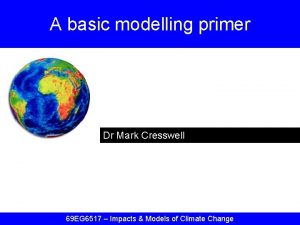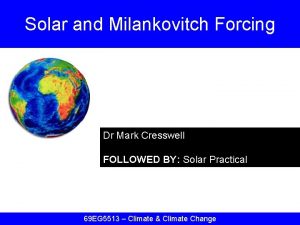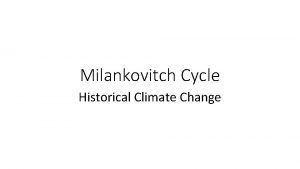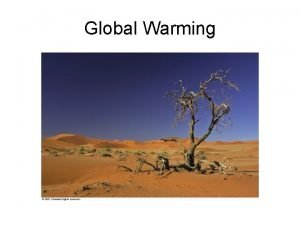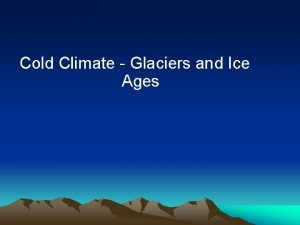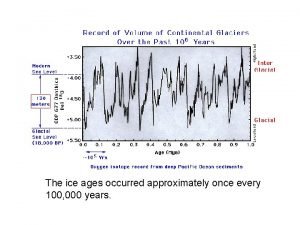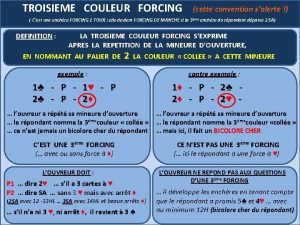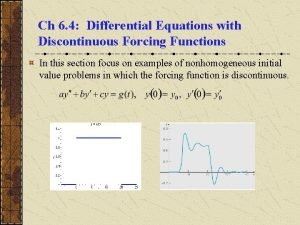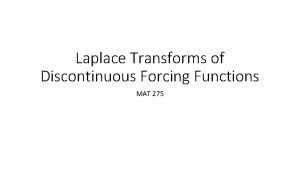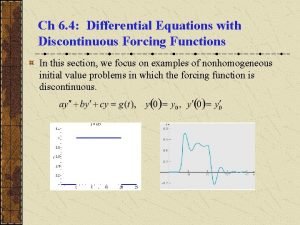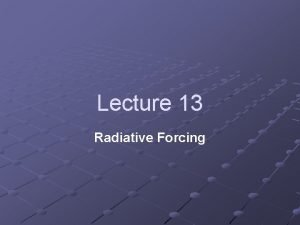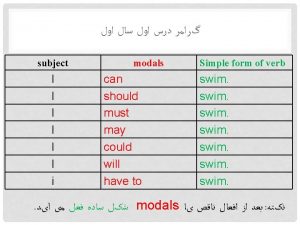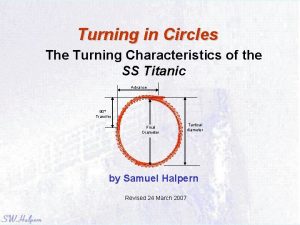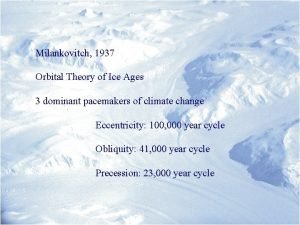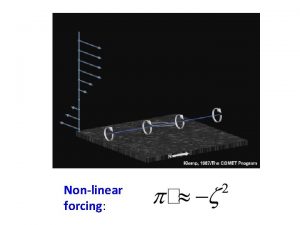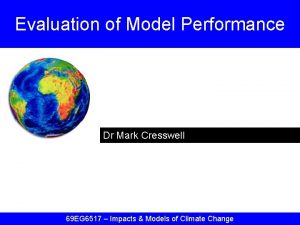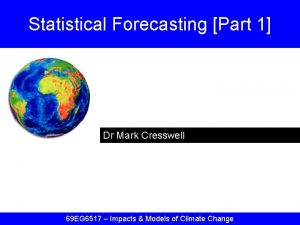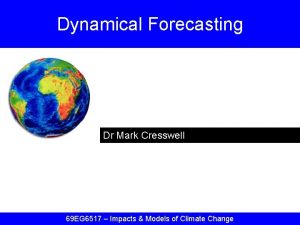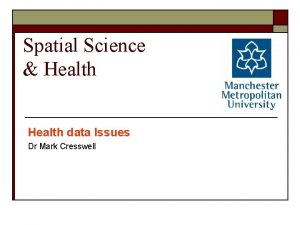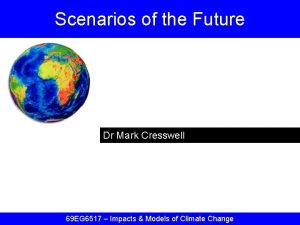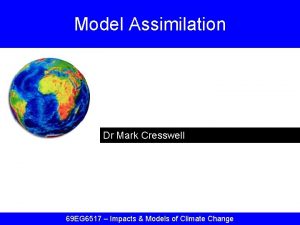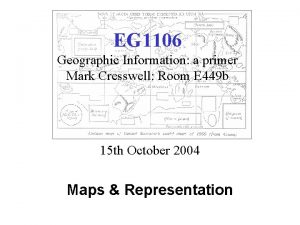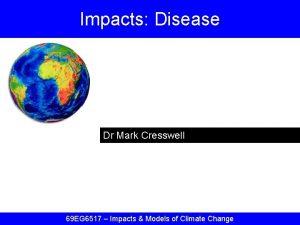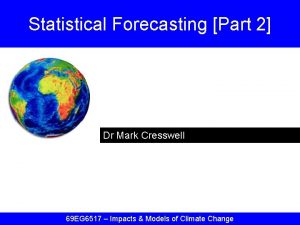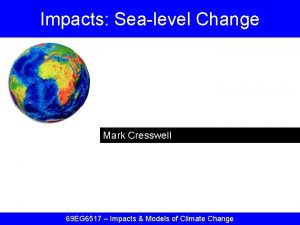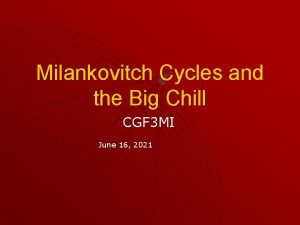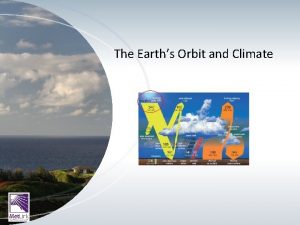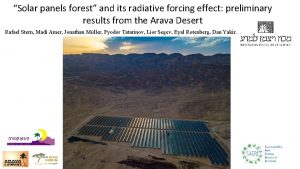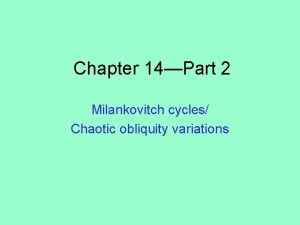Solar and Milankovitch Forcing Dr Mark Cresswell FOLLOWED




























- Slides: 28

Solar and Milankovitch Forcing Dr Mark Cresswell FOLLOWED BY: Solar Practical 69 EG 5513 – Climate & Climate Change

Lecture Topics • Introduction – a brief history of time • Natural – Milankovitch cycles • Natural – Solar Cycles

MPC Material http: //www. ukscience. org

INTRODUCTION

Is this a new phenomenon?

Introduction #1 It is known that our climate has experienced warmer and cooler phases throughout the past Sea levels regarded as rising at an “alarming” rate today have been considerably higher in the past

Introduction #2 • Proxy reconstructions for the climate of the Quaternary Period are considerably more abundant and reliable than for earlier periods • The Quaternary spans the last 2 My of Earth history and is separated into two Epochs, the Pleistocene (2 My to 10 Ky) and the Holocene (10 Ky to present)

Introduction #3 • Although deglaciation had been taking place for at least 4, 000 years, a rapid deterioration (cooling) in climate occurred at about 10 to 11 Ky • This event is known as the Younger Dryas Cooling. The North Atlantic polar front readvanced far southward to approximately 45°N (only 5 or 10° north of the glacial maximum position)

Introduction #4 Holocene thermal maximum: 6 to 7 thousand years ago

Introduction #5 • Quantitative estimates of mid-Holocene warmth suggest that the Earth was perhaps 1 or 2°C warmer than today • Most of this warmth may primarily represent seasonal (summer) warmth rather than year -round warmth

Introduction #6 • Beginning about 1450 A. D. there was a marked return to colder conditions. This interval is often called the Little Ice Age, a term used to describe an epoch of renewed glacial advance

Is this a new phenomenon?

MILANKOVITCH CYCLES

Milankovitch Cycles #1 • The distance between the Earth and Sun changes for a variety of reasons as does the quantity of solar energy reaching Earth • The Earth follows an elliptical orbit around the Sun. Orbital stretch/shrink ~100, 000 yrs

Milankovitch Cycles #2 • Milutin Milankovitch (a Serbian astrophysicist) worked out ways in which the Earth-Sun geometry changed as a function of orbital cycles

Milankovitch Cycles #3 Milankovitch Cycles: 1. Variations in the Earth's orbital eccentricity—the shape of the orbit around the sun. 2. Changes in obliquity—changes in the angle that Earth's axis makes with the plane of Earth's orbit 3. Precession—the change in the direction of the Earth's axis of rotation, i. e. , the axis of rotation behaves like the spin axis of a top that is winding down; hence it traces a circle on the celestial sphere over a period of time

Milankovitch Cycles #4 Illustration of ECCENTRICITY

Milankovitch Cycles #5 Illustration of OBLIQUITY

Milankovitch Cycles #6 Illustration of PRECESSION OF THE EQUINOXES

Milankovitch Cycles #7 Calculated Orbital Variation

SOLAR CYCLES

Solar Cycles #1 • There is really no such thing as a “solar constant” • We already know that orbital effects can change the quantity of solar radiation reaching the Earth • The Sun generates variable quantities of energy due to its own internal variability • Solar activity is know to have cycles – with a periodicity of about 11 years

The 11 year solar cycle

Solar Cycles #2 The 11 year solar cycle Historical overview of solar sunspot cycles

Solar Cycles #3 The 11 year solar cycle Historical overview of solar sunspot area from 1870 s to 2000

Solar Cycles #4 • As well as sunspot activity, the Sun can interact with our atmosphere by generating solar flares leading to a powerful solar “storm” (enhanced solar wind) • Solar flares can damage satellites, and can also affect the Van Allen belts producing Aurora (Northern Lights)

Solar Cycles #5 Coronal Mass Ejections (CMEs) are geomagnetic disturbances on the Sun surface that generates the Aurora Borealis.

Other Sources of Variability • • Urban heat island Ocean circulation Geothermal activity Tectonic plate movement Practical: Solar cycle variability Any questions ?
 Dr mark cresswell
Dr mark cresswell Dr mark cresswell
Dr mark cresswell Milutin milankovitch
Milutin milankovitch Precession milankovitch cycles
Precession milankovitch cycles Milankovitch cycles
Milankovitch cycles Paragraph about global warming
Paragraph about global warming Milankovitch cycles
Milankovitch cycles Milankovitch
Milankovitch Cresswell
Cresswell Cresswell
Cresswell Cresswell 2003
Cresswell 2003 Cresswell 2003
Cresswell 2003 Full-stem curl
Full-stem curl 3ème couleur forcing
3ème couleur forcing Importance of vegetable production
Importance of vegetable production Differential equations with discontinuous forcing functions
Differential equations with discontinuous forcing functions Transforms of discontinuous functions
Transforms of discontinuous functions Differential equations with discontinuous forcing functions
Differential equations with discontinuous forcing functions Radiative forcing definition
Radiative forcing definition Wholesale solar energy
Wholesale solar energy What is an inexhaustible source of energy
What is an inexhaustible source of energy Solar key mark
Solar key mark Voluntary standards examples
Voluntary standards examples Want object to infinitive
Want object to infinitive گرامر clause
گرامر clause Verbs followed by gerund or infinitive
Verbs followed by gerund or infinitive Parts of turning circle
Parts of turning circle 1 stressed syllable followed by 1 unstressed syllable
1 stressed syllable followed by 1 unstressed syllable Is samsung a cloner, imitator, or adapter?
Is samsung a cloner, imitator, or adapter?
